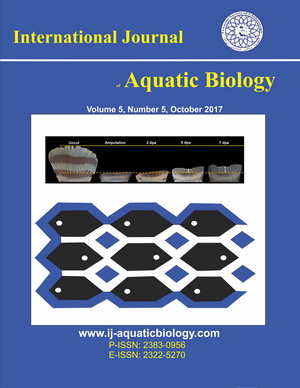Male reproductive evidence for the importance of gastropods as a sentinel species from Libong Island, Thailand
Downloads
A unique marine productive ecosystem of the seagrass beds on Thailand’s Libong has been identified, which may raise environmental concerns. However, limited data on the health status of marine animals, especially gastropods, as a good sentinel species, has been found. Therefore, the present study provides a detailed observation of the male reproductive health and spermatogenesis of three gastropod species, including Polinices mammilla, Cerithidea cingulata, and Nerita balteata as sentinel species, which are investigated using morphology and histological methods. All samples were collected randomly from seagrass areas with healthy and unhealthy conditions in April 2021. The samples’ male gonads were then investigated using histological methods. The results indicate that the species shared testicular structure and spermatogenesis in different stages (spermatogonium to spermatozoa). Additionally, their spermatogenic stages were not significantly different in size and diameter. Consequently, the structure of brown cells was common and distributed among the spermatogenic stages. Brown cells have been reported in animals that are under stress or unhealthy, such as in seagrass areas with unhealthy conditions. These results suggest that environmental and seagrass loss and the threatened seagrass habitats on Libong Island may impact aquatic animal health, necessitating long-term monitoring in further studies.
Downloads
Abbaci K., Joachirn S., Garric J., Boisseaux P., Exbrayat J., Porcher J., Geffard O. (2017). Anatomical and histological characterization of the gametogenesis of Radix balthica (linnaeus, 1758) in comparison with Lymnaea stagnalis (linnaeus, 1758). Journal of Histology and Histopathology, 4(1): 5.
Aya? Z., Ekmekçi G., Özmen M., Yerli S.V. (2007). Histopathological changes in the livers and kidneys of fish in Sariyar Reservoir, Turkey. Environmental Toxicology and Pharmacology, 23(2): 242-249.
Bauer G. (1987). Reproductive strategy of the freshwater pearl mussel Margaritifera margaritifera. Journal of Animal Ecology, 56(2): 691.
Carew M.E., Pettigrove V., Metzeling L., Hoffmann A.A. (2013). Environmental monitoring using next generation sequencing: rapid identification of macroinvertebrate bioindicator species. Frontiers in Zoology, 10(1): 45.
Chatchavalvanich K., Jindamongkon P., Kovitvadhi U., Thongpan A., Kovitvadhi S. (2006). Histological structure of gonads in the freshwater pearl mussel, Hyriopsis (Hyriopsis) bialatus Simpson, 1900. Invertebrate Reproduction and Development, 49(4): 245-253.
Chen S., Xia L., Dahms H., Xue P., Xiao Y. (2015). The ultrastructural characteristics of spermatogenesis in Onchidium struma (Pulmonata: Onchidiidae) and its functional adaptation. Italian Journal of Zoology, 82(4): 489-498.
Chiarelli R., Roccheri M.C. (2014). Marine invertebrates as bioindicators of heavy metal pollution. Open Journal of Metal, 04(04): 93-106.
Coe W.R. (1943). Sexual differentiation in mollusks I. pelecypods. The Quarterly Review of Biology, 18(2): 154-164.
de Jong-brink M., Boer H.H., Hommes T.G., Kodde A. (1977). Spermatogenesis and the role of sertoli cells in the freshwater snail Biomphalaria glabrata. Cell and Tissue Research, 181(1): 37-58.
Demin S.I., Stefanova V.N., Granovitch A.I., Mikhailova N.A. (2019). Spermatogenesis and lobular cyst type of testes organization in marine gastropod Littorina saxatilis (Olivi 1792). Cell and Tissue Research, 376(3): 457-470.
Dietrich D.R., Krieger H.O. (2009). Histological analysis of endocrine disruptive effects in small laboratory fish. https://doi.org/10.1002/9780470431795
Eckelbarger K.J., Davis C.V. (1996). Ultrastructure of the gonad and gametogenesis in the eastern oyster, Crassostrea virginica II. Testis and spermatogenesis. Marine Biology, 127(1): 89-96.
El-Gammal M.A.M., Al-Madan A., Fita N.A. (2016). Shrimp, crabs and squids as bio-indicators for heavy metals in Persian Gulf, Saudi Arabia. International Journal of Fisheries and Aquatic Studies, 4(6): 200-207.
Fernández San Juan M.R., Cortelezzi A., Albornoz C.B., Landro S., Arrighetti M.F., Najlea R. Lavarías S.M.L. (2020). Toxicity of pyrethroid cypermethrin on the freshwater snail Chilina parchappii: Lethal and sublethal effects. Ecotoxicology and Environmental Safety, 196: 110565.
Franco A., Kellner K., Goux D., Mathieu M., Berthelin C.H. (2011). Intragonadal Somatic Cells (ISCs) in the male oyster Crassostrea gigas: Morphology and contribution in germinal epithelium structure. Micron, 42(7): 718-725.
Ghiselin M.T. (2006). Sexual selection in hermaphrodites: where did our ideas come from? Integrative and Comparative Biology, 46(4): 368-372.
Giménez J. (2013). Spermatogenesis and sperm morphology in Trophon geversianus (Gastropoda: Muricidae). Journal of the Marine Biological Association of the United Kingdom, 93(7): 1881-1886.
Gosling, E. (2003). Bivalve Molluscs: Biology, ecology and culture. Hong Kong, Fishing News Books. 443 p.
Grande C., Araujo R., Ramos M.A. (2001). The gonads of Margaritifera auricularia (Spengler, 1793) and M. margaritifera (Linnaeus, 1758) (Bivalvia: Unionoidea). Journal of Molluscan Studies, 67(1): 27-36.
Heal J.M. (1991). Sperm morphology in the marine gastropod Architectonica perspectiva (Mollusca): Unique features and systematic relevance. Marine Biology, 109(1): 59-65.
Heard W., Heard W. (1975). Sexuality and other aspects of reproduction in Anodonta (Pelecypoda: Unionidae). Malacologia, 1: 81-103.
Hershler R., Ponder W.F. (1998). A review of morphological characters of hydrobioid snails. Smithsonian Contributions to Zoology, (600): 1-55.
Krupnova T.G., Mashkova I., Kostryukova A.M., Schelkanova E.E., Gavrilkina S.V. (2018). Gastropods as potential biomonitors of contamination caused by heavy metals in South Ural lakes, Russia. Ecological Indicators, 95: 1001-1007.
Lazorchak J.M., Hill B.H., Brown B.S., McCormick F.H., Engle V.D., Lattier D.J., Toth G.P. (2003). USEPA biomonitoring and bioindicator concepts needed to evaluate the biological integrity of aquatic systems. Bioindicators and Biomonitors, 831-874.
Lunetta G.D., Damiani F. (2002). Spermiogenesis in the vermetid gastropod Dendropoma petraeum (Gastropoda, Prosobranchia). European Journal of Histochemistry, 46(1): 75-86.
Mallet A., Jouvenel J., Broyon M., Pirot N., Geffroy B. (2021). Histology of Tritia mutabilis gonads: Using reproductive biology to support sustainable fishery management. Aquatic Living Resources, 34: 6.
Mylonas C.C., Fostier A., Zanuy S. (2010). Broodstock management and hormonal manipulations of fish reproduction. General and Comparative Endocrinology, 165(3): 516-534.
National Research Council (NRC). (1991). Animals as sentinel of environmental health hazards. Washington D.C.: National Academy Press.
Palma P., Takemura A., Libunao G.X., Superio J., De Jesus?Ayson E.G., Ayson F.G., Elizur A. (2019). Reproductive development of the threatened giant grouper Epinephelus lanceolatus. Aquaculture, 509: 1-7.
Pradit S., Towatana P., Nitiratsuwan T., Jualaong S., Jirajarus M., Sornplang K., Weerawong C. (2020). Occurrence of microplastics on beach sediment at Libong, a pristine island in Andaman Sea, Thailand. Science Asia, 46(3): 336.
Presnell J.K., Schreibman M.P., Humason G.L. (1997). Humason’s Animal tissue techniques. Baltimore: Johns Hopkins University Press. 600 p.
Reynoldson T.B., Metcalfe-Smith J.L. (1992). An overview of the assessment of aquatic ecosystem health using benthic invertebrates. Journal of Aquatic Ecosystem Health, 1(4): 295-308.
Roberts R.J. (1975). Melanin-containing cells of teleost fish and their relation to disease. In: The Pathology of Fishes. University of Wisconsin. pp:?399-428.
Roosen?Runge E.C. (1977). The process of spermatogenesis in animals. The Quarterly Review of Biology, 53: 315.
Senarat S., Kettratad J., Poolprasert P., Yenchum W., Jiraungkoorskul W. (2015). Histopathological finding of liver and kidney tissues of the yellow mystus, Hemibagrus filamentus (Fang and Chaux, 1949), from the Tapee River, Thailand. Songklanakarin Journal of Science and Technology, 37(1): 1-5.
Shepardson S., Heard W.H., Breton S., Hoeh W.R. (2012). Light and transmission electron microscopy of two spermatogenic pathways and unimorphic spermatozoa in Venustaconcha ellipsiformis (Conrad, 1836) (Bivalvia: Unionoida). Malacologia, 55(2): 263-284.
Sousa R., Delgado J.M.P.Q., González J.A., Freitas M., Henriques P. (2018). Marine snails of the Genus Phorcus: Biology and ecology of sentinel species for human impacts on the rocky shores. Biological Resources of Water, 141-167.
Steinel N.C., Bolnick D.I. (2017). Melanomacrophage centers as a histological indicator of immune function in fish and other poikilotherms. Frontiers in Immunology, 8: 827.
Suvarna S.K., Layton C., Bancroft J.D. (2013). Bancroft’s theory and practice of histological techniques. Canada, Elsevier. SBN: 978-0-7020-4226-3.
Wilson J.M., Bunte R.M., Carty A.J. (2009). Evaluation of rapid cooling and tricaine methanesulfonate (MS222) as methods of euthanasia in zebrafish (Danio rerio). Journal of the American Association for Laboratory Animal Science, 48(6): 785-789.
Wu J., Wu Y., Li M.C., Chiu Y.W., Liu M.Y., Liu L.L. (2011). Reproduction and juvenile growth of the invasive apple snails Pomacea canaliculata and P. scalaris (Gastropoda: Ampullariidae) in Taiwan. Zoological Studies, 50(1): 61-68.
Zaroogian G.E., Anderson S. (1995). Comparison of cadmium, nickel and benzo (a) pyrene uptake into cultured brown cells of the hard shell clam, Mercenaria mercenaria. Comparative Biochemistry and Physiology Part C: Pharmacology, Toxicology and Endocrinology, 111(1): 109-116.
Zaroogian G.E., Jackim E. (2000). In vivo metallothionein and glutathione status in an acute response to cadmium in Mercenaria mercenaria brown cells. Comparative Biochemistry and Physiology Part C: Pharmacology, Toxicology and Endocrinology, 127(3): 251-261.
Zorita I., Apraiz I., Ortiz-Zarragoitia M., Orbea A., Cancio I., Soto M., Cajaraville M.P. (2007). Assessment of biological effects of environmental pollution along the NW Mediterranean Sea using mussels as sentinel organisms. Environmental Pollution, 148(1): 236-250.
Zorita I., Ortiz-Zarragoitia M., Soto M., Cajaraville M.P. (2006). Biomarkers in mussels from a copper site gradient (Visnes, Norway): An integrated biochemical, histochemical and histological study. Aquatic Toxicology, 78: 109-116.
Copyright (c) 2024 International Journal of Aquatic Biology

This work is licensed under a Creative Commons Attribution 4.0 International License.








